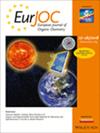催化不对称加成和取代反应与格氏试剂:我们知道这一切吗?
IF 2.5
3区 化学
Q2 CHEMISTRY, ORGANIC
引用次数: 0
摘要
催化一直是有机合成的基石,使各种高效和选择性的C-C键形成反应成为可能,特别是格氏试剂的对映选择性加成和取代。随着时间的推移,我们对各种因素(如金属来源的影响、配体的性质、底物或温度)如何影响这些过程有了重要的了解。计算化学的最新进展进一步丰富了我们对这种化学的理解,阐明了潜在的反应机制,并提供了对这些催化转化的速率和对映体决定步骤的见解。然而,挑战依然存在,配体优化、完整的机制理解和可扩展性等方面仍未得到充分探索。然而,计算方法显示出克服这些持久挑战的巨大潜力。本文章由计算机程序翻译,如有差异,请以英文原文为准。

Catalytic Asymmetric Addition and Substitution Reactions with Grignard Reagents: Do We Know It All?
Catalysis has been a cornerstone in organic synthesis, enabling a variety of highly efficient and selective C−C bond formation reactions, in particular enantioselective addition and substitution of Grignard reagents. Throughout time, we have gained significant understanding into how various factors, such as the influence of the metal source, the nature of the ligands, the substrates or temperature, affect these processes. Recent advances in computational chemistry have further enriched our understanding of this chemistry by elucidating the potential reaction mechanism and providing insight into the rate and enantio‐determining steps in these catalytic transformations. However, challenges persist, and aspects such as ligand optimisation, full mechanistic understanding and scalability remain underexplored. Computational methods, however, present a remarkable potential to surmount these enduring challenges.
求助全文
通过发布文献求助,成功后即可免费获取论文全文。
去求助
来源期刊
CiteScore
5.40
自引率
3.60%
发文量
752
审稿时长
1 months
期刊介绍:
The European Journal of Organic Chemistry (2019 ISI Impact Factor 2.889) publishes Full Papers, Communications, and Minireviews from the entire spectrum of synthetic organic, bioorganic and physical-organic chemistry. It is published on behalf of Chemistry Europe, an association of 16 European chemical societies.
The following journals have been merged to form two leading journals, the European Journal of Organic Chemistry and the European Journal of Inorganic Chemistry:
Liebigs Annalen
Bulletin des Sociétés Chimiques Belges
Bulletin de la Société Chimique de France
Gazzetta Chimica Italiana
Recueil des Travaux Chimiques des Pays-Bas
Anales de Química
Chimika Chronika
Revista Portuguesa de Química
ACH—Models in Chemistry
Polish Journal of Chemistry.

 求助内容:
求助内容: 应助结果提醒方式:
应助结果提醒方式:


